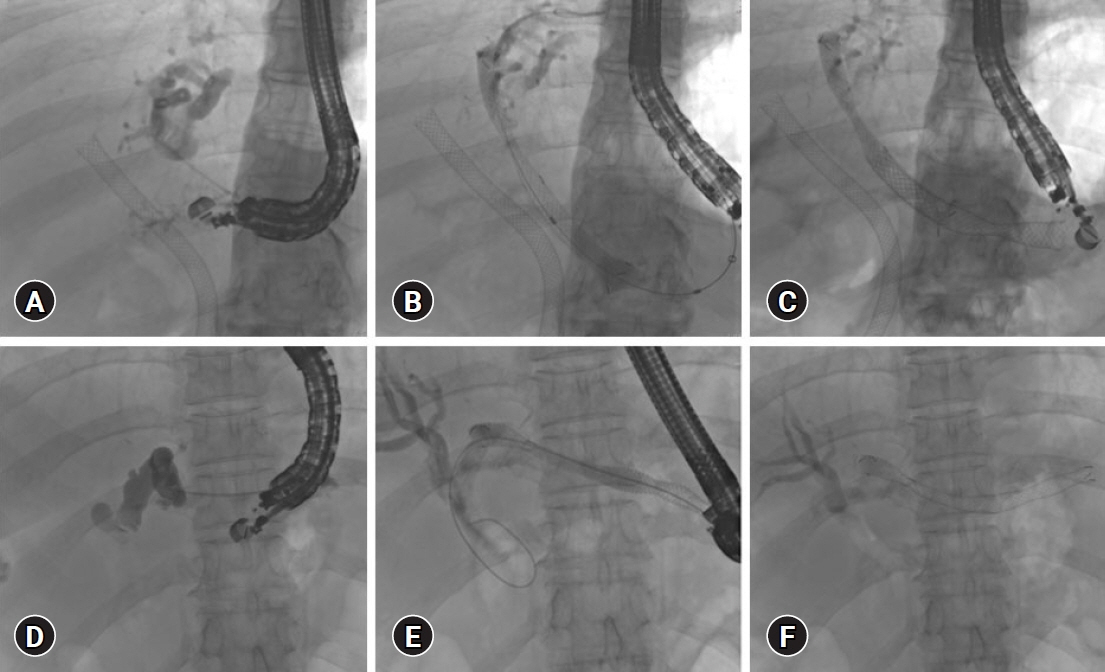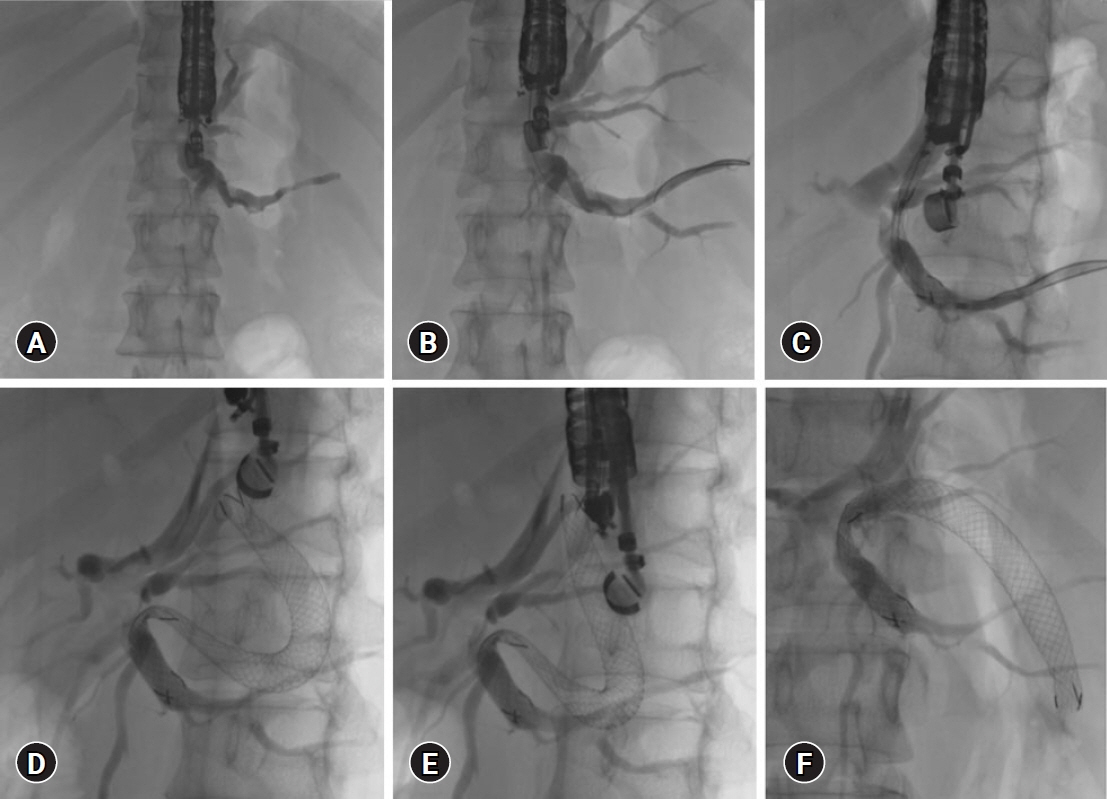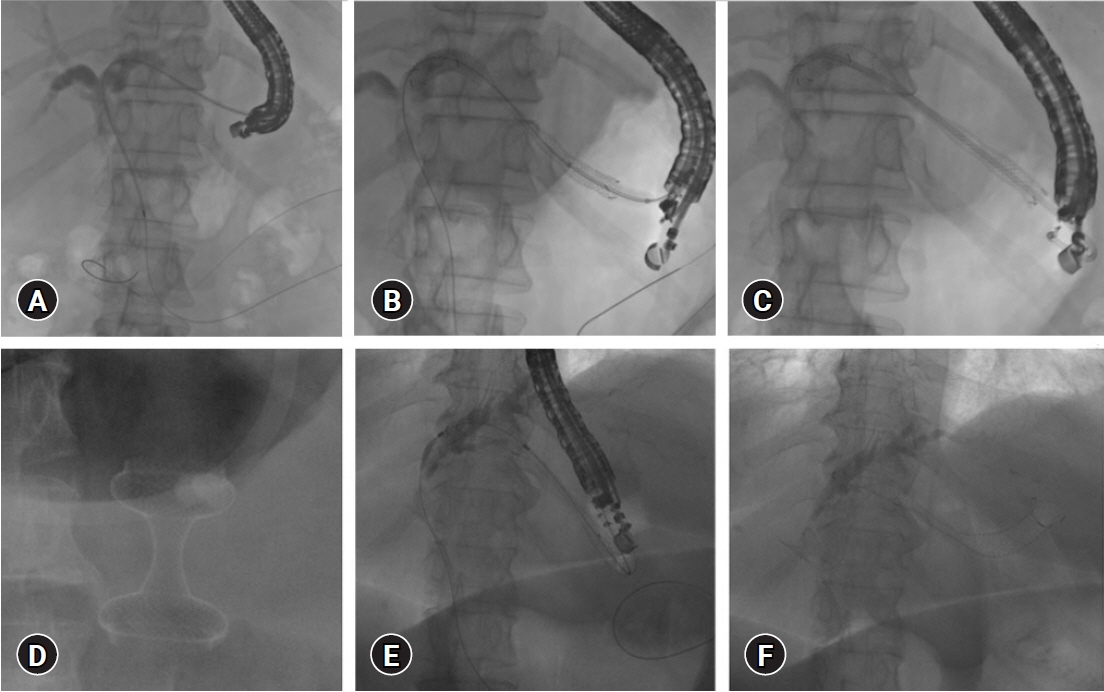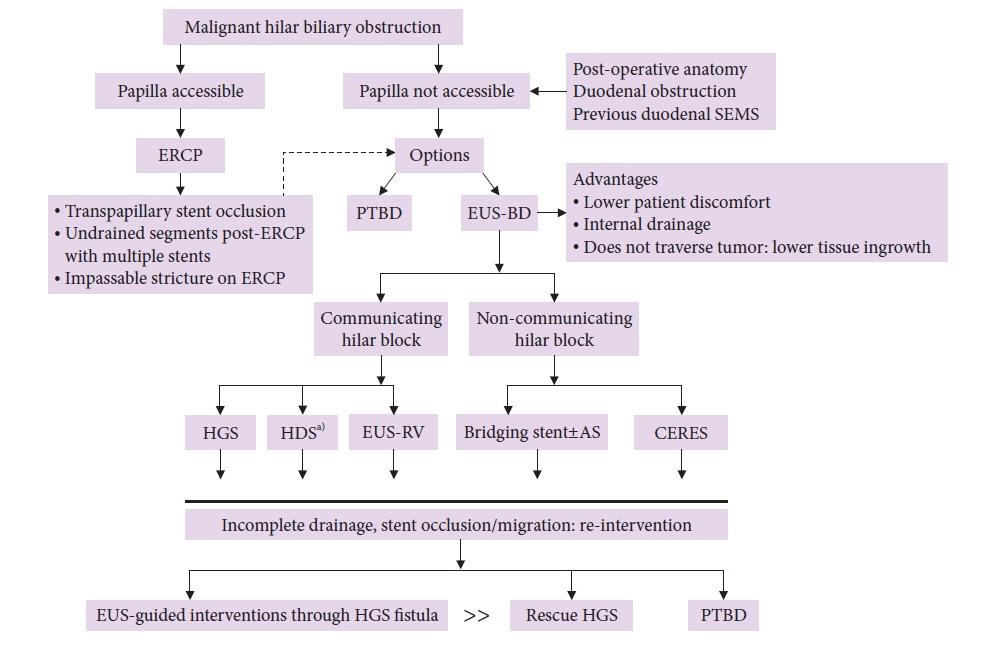Clin Endosc.
2023 Mar;56(2):143-154. 10.5946/ce.2022.198.
Endoscopic ultrasound-guided intervention for inaccessible papilla in advanced malignant hilar biliary obstruction
- Affiliations
-
- 1Department of Medical Gastroenterology, Asian Institute of Gastroenterology, Hyderabad, India
- KMID: 2540729
- DOI: http://doi.org/10.5946/ce.2022.198
Abstract
- Advanced malignant hilar biliary obstruction (MHBO) with inaccessible papilla poses a significant challenge to endoscopists, as drainage of multiple liver segments may be warranted. Transpapillary drainage may not be feasible in patients with surgically altered anatomy, duodenal stenosis, prior duodenal self-expanding metal stent, and after initial transpapillary drainage, but require re-intervention for draining separated liver segments. Endoscopic ultrasound-guided biliary drainage (EUS-BD) and percutaneous trans-hepatic biliary drainage are the feasible options in this scenario. The major advantages of EUS-BD over percutaneous trans-hepatic biliary drainage include a reduction in patient discomfort and internal drainage away from the tumor, thus reducing the possibility of tissue or tumor ingrowth. With innovations, EUS-BD is helpful not only for bilateral communicating MHBO but also for non-communicating systems with bridging hilar stents or isolated right intra-hepatic duct drainage by hepatico-duodenostomy. EUS-guided multi-stent drainage with specially designed cannulas and guidewires has become a reality. A combined approach with endoscopic retrograde cholangiopancreatography for re-intervention, interventional radiology, and intraductal tumor ablative therapies has been reported. Stent migration and bile leakage can be minimized with proper stent selection and technique, and stent blocks can be managed with EUS-guided interventions in a majority of cases. Future comparative studies are required to establish the role of EUS-guided interventions in MHBO as rescue or primary therapy.
Keyword
Figure
Reference
-
1. Yasuda I, Mukai T, Moriwaki H. Unilateral versus bilateral endoscopic biliary stenting for malignant hilar biliary strictures. Dig Endosc. 2013; 25 Suppl 2:81–85.2. Sundaram S, Dhir V. EUS-guided biliary drainage for malignant hilar biliary obstruction: a concise review. Endosc Ultrasound. 2021; 10:154–160.3. Khoo S, Do ND, Kongkam P. Efficacy and safety of EUS biliary drainage in malignant distal and hilar biliary obstruction: a comprehensive review of literature and algorithm. Endosc Ultrasound. 2020; 9:369–379.4. Ishikawa K, Ishiwatari H, Niiya F, et al. Combined ERCP and endoscopic ultrasound-guided antegrade stenting for hilar biliary obstruction in a patient after pancreatoduodenectomy. Endoscopy. 2022; 54(S 02):E888–E889.5. Minaga K, Takenaka M, Kitano M, et al. Rescue EUS-guided intrahepatic biliary drainage for malignant hilar biliary stricture after failed transpapillary re-intervention. Surg Endosc. 2017; 31:4764–4772.6. Ogura T, Masuda D, Takeuchi T, et al. Simplified reintervention method of EUS-guided hepaticogastrostomy stent obstruction. Gastrointest Endosc. 2016; 83:831.7. Yamauchi H, Kida M, Miyazawa S, et al. Endoscopic ultrasound-guided antegrade metal stent placement using the stent-in-stent technique in a patient with malignant hilar biliary obstruction. Endosc Ultrasound. 2018; 7:204–206.8. Giovannini M, Dotti M, Bories E, et al. Hepaticogastrostomy by echo-endoscopy as a palliative treatment in a patient with metastatic biliary obstruction. Endoscopy. 2003; 35:1076–1078.9. Bories E, Pesenti C, Caillol F, et al. Transgastric endoscopic ultrasonography-guided biliary drainage: results of a pilot study. Endoscopy. 2007; 39:287–291.10. Park DH, Song TJ, Eum J, et al. EUS-guided hepaticogastrostomy with a fully covered metal stent as the biliary diversion technique for an occluded biliary metal stent after a failed ERCP (with videos). Gastrointest Endosc. 2010; 71:413–419.11. Panpimanmas S, Ratanachu-ek T. Endoscopic ultrasound-guided hepaticogastrostomy for hilar cholangiocarcinoma: the first trial in Thailand. J Med Assoc Thai. 2011; 94 Suppl 2:S129–S134.12. Panpimanmas S, Ratanachu-ek T. Endoscopic ultrasound-guided hepaticogastrostomy for advanced cholangiocarcinoma after failed stenting by endoscopic retrograde cholangiopancreatography. Asian J Surg. 2013; 36:154–158.13. Ogura T, Onda S, Takagi W, et al. Clinical utility of endoscopic ultrasound-guided biliary drainage as a rescue of re-intervention procedure for high-grade hilar stricture. J Gastroenterol Hepatol. 2017; 32:163–168.14. Ogura T, Masuda D, Imoto A, et al. EUS-guided hepaticogastrostomy for hepatic hilar obstruction. Endoscopy. 2014; 46 Suppl 1 UCTN:E32–E33.15. Reimão S, Francioni E, Bories E, et al. Endoscopic ultrasonography-guided bi-lateral biliary drainage: a case series study. Endosc Ultrasound. 2014; 3(Suppl 1):S18.16. Caillol F, Bosshardt C, Reimao S, et al. Drainage of the right liver under EUS guidance: a bridge technique allowing drainage of the right liver through the left liver into the stomach or jejunum. Endosc Ultrasound. 2019; 8:199–203.17. Prachayakul V, Aswakul P. Endoscopic ultrasound-guided biliary drainage: bilateral systems drainage via left duct approach. World J Gastroenterol. 2015; 21:10045–10048.18. Mukai S, Itoi T, Tsuchiya T, et al. EUS-guided right hepatic bile duct drainage in complicated hilar stricture. Gastrointest Endosc. 2017; 85:256–257.19. Hijioka S, Sakamoto Y, Ohba A, et al. Novel simultaneous endoscopic ultrasound-guided hepaticoduodenostomy and hepaticogastrostomy for recurrent hepatic hilar obstruction. Endoscopy. 2018; 50:E320–E322.20. Kanai S, Saito T, Hakuta R, et al. Transverse stent placement for hilar malignant biliary obstruction through an endoscopic ultrasound-guided hepaticogastrostomy route. Endoscopy. 2019; 51:E245–E246.21. Ogura T, Sano T, Onda S, et al. Endoscopic ultrasound-guided biliary drainage for right hepatic bile duct obstruction: novel technical tips. Endoscopy. 2015; 47:72–75.22. Ma KW, So H, Cho DH, et al. Durability and outcome of endoscopic ultrasound-guided hepaticoduodenostomy using a fully covered metal stent for segregated right intrahepatic duct dilatation. J Gastroenterol Hepatol. 2020; 35:1753–1760.23. Uchida D, Kato H, Okada H. Re-intervention with endoscopic ultrasound-guided hepaticogastrostomy for unresectable hilar biliary drainage using a multipath occlusion balloon. Endoscopy. 2018; 50:450–452.24. Okuno N, Hara K, Mizuno N, et al. Efficacy of the 6-mm fully covered self-expandable metal stent during endoscopic ultrasound-guided hepaticogastrostomy as a primary biliary drainage for the cases estimated difficult endoscopic retrograde cholangiopancreatography: a prospective clinical study. J Gastroenterol Hepatol. 2018; 33:1413–1421.25. Nakai Y, Sato T, Hakuta R, et al. Long-term outcomes of a long, partially covered metal stent for EUS-guided hepaticogastrostomy in patients with malignant biliary obstruction (with video). Gastrointest Endosc. 2020; 92:623–631.26. Kawakami H, Kubota Y, Makiyama H, et al. Uneven double-lumen cannula for rescue guidewire technique in endoscopic ultrasonography-guided hepaticogastrostomy. Endoscopy. 2017; 49:E264–E265.27. Ishiwatari H, Satoh T, Sato J, et al. Double-guidewire technique facilitates endoscopic ultrasound-guided biliary drainage for hilar biliary obstruction. Endoscopy. 2019; 51:E321–E322.28. Moryoussef F, Sportes A, Leblanc S, et al. Is EUS-guided drainage a suitable alternative technique in case of proximal biliary obstruction? Therap Adv Gastroenterol. 2017; 10:537–544.29. Winkler J, Caillol F, Ratone JP, et al. Feasibility of EUS-guided hepaticogastrostomy for inoperable malignant hilar biliary strictures. Endosc Ultrasound. 2021; 10:51–56.30. Takenaka M, Kudo M. Endoscopic reintervention for recurrence of malignant biliary obstruction: developing the best strategy. Gut Liver. 2022; 16:525–534.31. Kitamura H, Hijioka S, Nagashio Y, et al. Use of endoscopic ultrasound-guided biliary drainage as a rescue of re-intervention after the placement of multiple metallic stents for malignant hilar biliary obstruction. J Hepatobiliary Pancreat Sci. 2022; 29:404–414.32. Harai S, Hijioka S, Maruki Y, et al. Endoscopic ultrasound-guided hepaticoduodenostomy with anterograde stenting for recurrent hepatic hilar obstruction. Endoscopy. 2022; 54:E398–E400.33. Yamamura M, Ogura T, Ueno S, et al. Endoscopic bilateral revision after metal stent deployment for hepatic hilar obstruction using molting technique (with videos). Therap Adv Gastroenterol. 2022; 15:17562848211062803.34. Kongkam P, Orprayoon T, Boonmee C, et al. ERCP plus endoscopic ultrasound-guided biliary drainage versus percutaneous transhepatic biliary drainage for malignant hilar biliary obstruction: a multicenter observational open-label study. Endoscopy. 2021; 53:55–62.35. Perez-Miranda M. Combined ERCP and transhepatic endoscopic ultrasound-guided stent placement for biliary drainage in malignant hilar obstruction: not too good to be true. Endoscopy. 2021; 53:63–64.36. Koshitani T, Nakagawa S, Itoh Y. EUS-guided antegrade stent placement for unresectable malignant hilar biliary strictures by use of a stent-in-stent method. Gastrointest Endosc. 2018; 87:309–310.37. Suenaga S, Kaino S, Tsuyama T, et al. EUS-guided antegrade metallic stent placement using the stent-in-stent method with a 6-Fr novel slim delivery system in a patient with malignant hilar biliary obstruction. Endosc Ultrasound. 2021; 10:387–389.38. Iwano K, Kurita A, Yazumi S. Multi-stent technique via one endoscopic ultrasonography-guided hepaticogastrostomy fistula for malignant hilar obstruction. Dig Endosc. 2020; 32:e63–e64.39. Eum J, Park DH, Ryu CH, et al. EUS-guided biliary drainage with a fully covered metal stent as a novel route for natural orifice transluminal endoscopic biliary interventions: a pilot study (with videos). Gastrointest Endosc. 2010; 72:1279–1284.40. Hashim A, Bessissow A, Valenti D, et al. Endoscopic ultrasound-guided biliary drainage in high grade biliary hilar obstruction. Endoscopy. 2019; 51:E284–E285.41. Chantarojanasiri T, Ratanachu-Ek T, Pausawasdi N. What you need to know before performing endoscopic ultrasound-guided hepaticogastrostomy. Clin Endosc. 2021; 54:301–308.42. Minaga K, Kitano M, Yamashita Y, et al. Stent migration into the abdominal cavity after EUS-guided hepaticogastrostomy. Gastrointest Endosc. 2017; 85:263–264.43. Cho JH, Park SW, Kim EJ, et al. Long-term outcomes and predictors of adverse events of EUS-guided hepatico-gastrostomy for malignant biliary obstruction: multicenter, retrospective study. Surg Endosc. 2022; 36:8950–8958.44. James TW, Baron TH. Practical applications and learning curve for EUS-guided hepaticoenterostomy: results of a large single-center US retrospective analysis. Endosc Int Open. 2019; 7:E600–E607.
- Full Text Links
- Actions
-
Cited
- CITED
-
- Close
- Share
- Similar articles
-
- Endoscopic ultrasound-guided biliary drainage in malignant hilar obstruction
- Endoscopic Ultrasound-Guided Biliary Drainage for Unresectable Hilar Malignant Biliary Obstruction
- Proper management of inoperable malignant hilar biliary obstruction: Endoscopic retrograde cholangiopancreatography, endoscopic ultrasound, or percutaneous approach?
- Endoscopic ultrasound-guided biliary drainage in malignant distal biliary obstruction
- Bilateral Metallic Stenting in Malignant Hilar Obstruction





